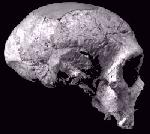 (Existed 100 000 Years Ago)
(Existed 100 000 Years Ago)
The Neaderdthalers (Homo sapines neanderthalensis)were a widespread species of prehistoric humans that inhabited Europe, Asia and South Africa prior to the appearance of anatomically modern humans. The first Neanderthal skeletal material was discovered accidentally in 1856 by quarrymen in a cave in Neander valley in Germany. It was the first early-human fossil to be recognized by scientists. In 1863, British biologist, Thomas Henry Huxley published a description od the more primitive aspects of the fossil, suggesting it formed a link between modern humans and apes. By stressing these features,Huxley laid the foundations for the view of Neanderthals as primitive, bent-kneed, half-witted creatures. Other scientists reinforced this view by pointing out certain features in another fossil studied, such as the low forehead with strong brow ridges and inflated faces lacking a chin, suggesting that these species were too extreme to have evolved into the modern human of today. One of the scientists proposing this theory, Marcelin Boule, pushed furthur as to say that Neanderthals represented a side branch of humans that became extinct shortly before the apparition of Cro Magnon.

Many scientists still believe that Neanderthals became extinct, while others hold that in comparison with older fossil forms, such has Homo erectus, the Neanderthals share a great deal of physical traits ressembling those of modern man. These traits include brian size, locomotor ability, manual dexterity and the ability for symbolic behavior. This would suggest that Neanderthals may have been the immediate ancestor to modern humans. Recent research also indicates that Neanderhtals had a capacity for speech, and may have co-existed with Cro Magnon in some areas up to a few millenia before the Neanderthals died out.
Throughout Europe, the Middle East and North Africa, stone tools have been discovered with Neanderthal remains. These tools include scrapers, knives, chisels, point, cleavers and blades, exhibiting superior workmanship over the tools presented in the Homo erectus era of evolution. There is also much evidence of ritual behavior exhibited in the discovery of more than a dozen Neanderthal grave sites ranging from simple pit burials to stonelined tomb chambers.